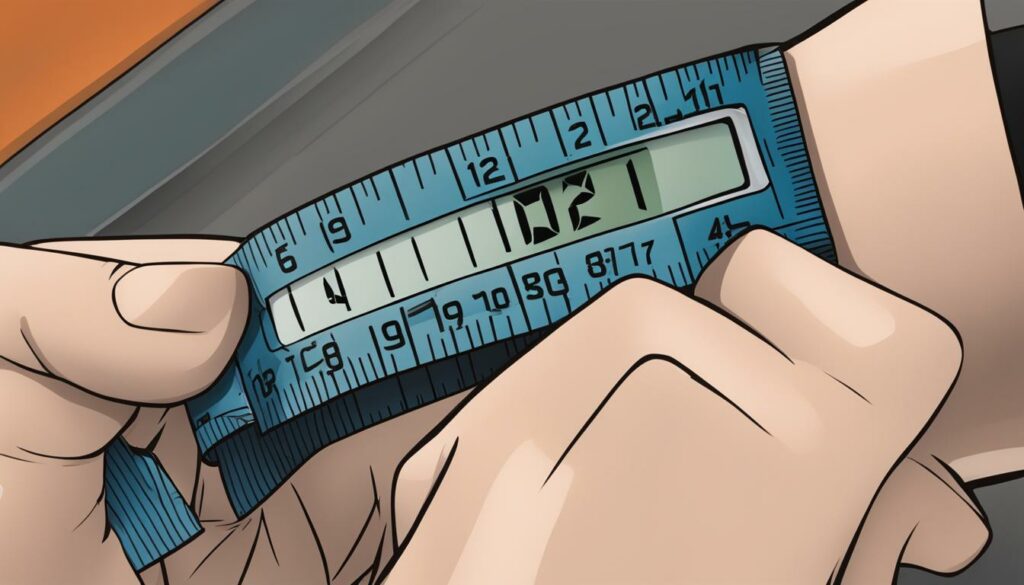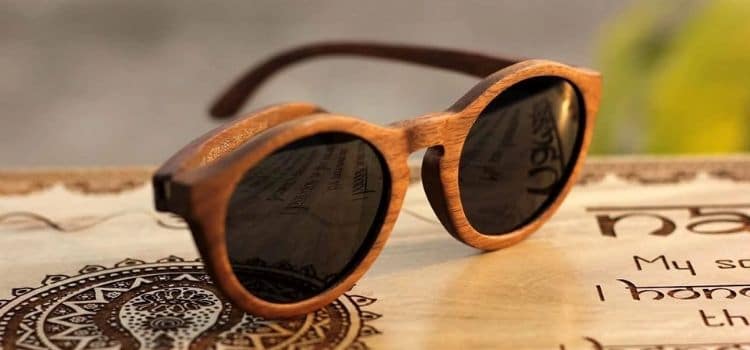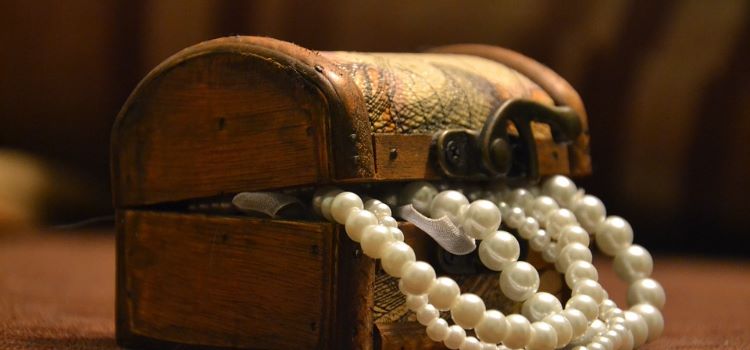Welcome to my easy guide on how to measure your wrist accurately at home! Whether you’re shopping for a stylish watch, a beautiful bracelet, or an activity tracker, getting the right fit is essential. In this article, I’ll provide you with step-by-step instructions and useful tips on measuring your wrist size. From using a measuring tape or ruler to smartphone apps, I’ll cover various methods to ensure you find the perfect size for your wrist. Let’s get started with the basics – how to measure your wrist!
Before we dive into the details, let’s familiarize ourselves with some keywords: how to measure wrist, wrist measurement, measuring wrist size, wrist size calculator, wrist sizing guide, and wrist measurement tool. These terms will help us navigate through the different sections of this comprehensive guide. Now, let’s explore the importance of measuring your wrist size!
Why Measuring Your Wrist Size is Important
Accurate wrist measurement is of utmost importance when it comes to finding the perfect fit for your watches and bracelets. Taking the time to measure your wrist ensures a comfortable and secure fit, preventing any discomfort or damage to your wrist. Additionally, measuring your wrist size allows you to choose the correct size when shopping online, reducing the likelihood of returns or exchanges.
By measuring your wrist, you can avoid wearing accessories that are too tight or too loose, which can cause irritation or even result in loss. A properly fitting watch or bracelet ensures that it stays in place throughout the day, allowing you to wear your favorite pieces with confidence. Moreover, an accurate wrist measurement guarantees a comfortable fit, as it takes into account the unique size and shape of your wrist.
For online shoppers, knowing your wrist size can save you time and hassle. By providing your accurate wrist measurement, you can confidently select the right size without the need for multiple returns or exchanges. This is especially important when purchasing limited edition or customized pieces that may not be eligible for returns.
Benefits of Accurate Wrist Measurement
- Comfortable and secure fit for watches and bracelets
- Prevents discomfort or damage to the wrist
- Reduces the likelihood of returns or exchanges
- Confidently shop online with accurate measurements
- Saves time and hassle by avoiding multiple returns
“Accurate wrist measurement ensures a comfortable and secure fit for your watches and bracelets.”
Proper Fit for Watches and Bracelets
Properly measuring your wrist size allows you to find the perfect fit for different types of watches and bracelets. Whether you’re looking for a closed loop bangle, an open loop bracelet, or a watch with a metal band, accurate measurements ensure a comfortable and stylish fit.
When it comes to closed loop bangles, measuring around your knuckles provides the right size to slip the bracelet over your hand. For open loop bracelets, measuring the width of your wrist allows you to select the appropriate size that will hang comfortably. And for watches with metal bands, a slightly looser fit ensures a comfortable wearing experience.
| Bracelet Type | Measurement Method |
|---|---|
| Closed Loop Bangle | Measure around your knuckles |
| Open Loop Bracelet | Measure the width of your wrist |
| Watch with Metal Band | Opt for a slightly looser fit |
By following these guidelines and considering the specific fit requirements for different types of jewelry, you can ensure that your accessories fit perfectly, enhancing your overall style and comfort.
Method 1: Using a Measuring Tape or Ruler
One of the simplest and most accurate methods to measure your wrist size is using a measuring tape or ruler. This method is ideal for determining the size of watches or standard link bracelets. Here’s how you can do it:
- Take a flexible measuring tape and wrap it around the widest part of your wrist, just below the bone.
- Make sure the tape is snug but not too tight.
- Read the measurement in inches or centimeters and record it.
If you don’t have a flexible measuring tape, you can use a ruler as an alternative. Place the ruler around your wrist, parallel to the ground, and take the measurement in the same way as with the measuring tape. It’s important to ensure accuracy by keeping the measuring tape or ruler level and straight while taking the measurement.
Using a measuring tape or ruler is a straightforward and reliable method to determine your wrist size. It provides an accurate measurement that can help you find the right fit for your watches and bracelets.
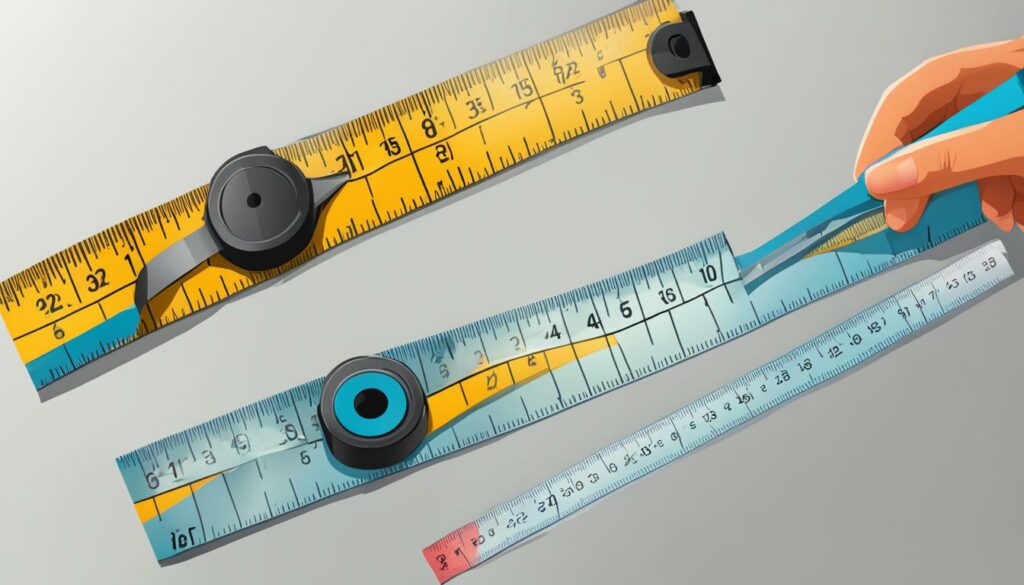
Comparison Table: Measuring Tape vs. Ruler
| Measuring Tape | Ruler |
|---|---|
| Flexible and easy to wrap around wrist | Straight and rigid, may require assistance |
| Accurate and precise measurement | May be slightly less accurate |
| Available in both inches and centimeters | May only provide measurements in inches |
| Convenient for self-measurement | Requires assistance for accurate measurement |
As seen in the comparison table above, both the measuring tape and ruler have their advantages and considerations. Choose the method that works best for you based on availability and ease of use.
Method 2: Using a String and Ruler
If you don’t have a measuring tape or ruler at hand, don’t worry! You can still accurately measure your wrist size using a simple piece of string and a ruler. This method is especially useful for open loop bracelets or when a flexible measuring tape is not available.
Here’s how you can measure your wrist using a string and ruler:
- First, take a piece of string or ribbon.
- Wrap the string around your wrist, making sure it is snug but not too tight.
- When the string overlaps, mark the point of overlap with a pen or marker.
- Remove the string from your wrist and lay it flat on a ruler.
- Read the length of the string from the starting point to the marked point. This measurement represents the circumference of your wrist.
Using a string and ruler provides an easy and accessible way to measure your wrist size accurately. Now you can confidently find the perfect fit for your open loop bracelets or any other jewelry that requires a precise wrist measurement.
Method 2: Using a String and Ruler
If you don’t have a measuring tape or ruler at hand, don’t worry! You can still accurately measure your wrist size using a simple piece of string and a ruler. This method is especially useful for open loop bracelets or when a flexible measuring tape is not available.
Here’s how you can measure your wrist using a string and ruler:
- First, take a piece of string or ribbon.
- Wrap the string around your wrist, making sure it is snug but not too tight.
- When the string overlaps, mark the point of overlap with a pen or marker.
- Remove the string from your wrist and lay it flat on a ruler.
- Read the length of the string from the starting point to the marked point. This measurement represents the circumference of your wrist.
Using a string and ruler provides an easy and accessible way to measure your wrist size accurately. Now you can confidently find the perfect fit for your open loop bracelets or any other jewelry that requires a precise wrist measurement.
Method 3: Using an App
If you prefer a more modern approach to measuring your wrist size, you can utilize smartphone apps that are specifically designed for this purpose. These innovative apps allow you to accurately measure your wrist using the sensors and technology built into your phone.
By downloading a wrist measurement app, you can follow the step-by-step instructions provided to ensure precise measurements. These apps typically utilize the screen of your smartphone to measure your wrist circumference, making it a convenient and user-friendly option. Simply place your phone against your wrist as instructed and let the app do the rest!
Using an app to measure your wrist size eliminates the need for physical measuring tools and provides a hassle-free experience. Whether you’re shopping for a watch, bracelet, or activity tracker, using a wrist measurement app can help you find the perfect fit without any guesswork.

Note: Remember to download apps only from reliable sources and read reviews to ensure accuracy and user satisfaction.
Tips for Measuring Wrist Size for Different Types of Jewelry
When it comes to measuring your wrist size for different types of jewelry, there are a few key factors to consider. The size requirements may vary depending on the style of the piece you’re looking to wear. Whether it’s a closed loop bangle, an open loop bracelet, or a bangle that fits around your knuckles, here are some useful tips to ensure a perfect fit:
Measuring Wrist Size for Closed Loop Bangles
For closed loop bangles that fit snugly around your wrist, it’s important to measure not just the circumference of your wrist, but also the width of your hand where the bangle needs to pass through. This ensures that you can comfortably slide the bangle onto your hand without any restrictions. Use a measuring tape or a piece of string to accurately measure the circumference of your hand at its widest point. Consider adding a bit of extra length for a comfortable fit.
Measuring Wrist Width for Open Loop Bracelets
Open loop bracelets, such as cuff bracelets or bangles that have a gap, require a slightly different measurement. Instead of measuring the circumference of your wrist, measure the width of your wrist at its widest point. This will help you determine the size of the bracelet that will fit comfortably and securely. Be sure to consider whether the bracelet is adjustable or not, as this can affect sizing options.
Measuring Knuckles for Bangles
When it comes to bangles that need to fit around your knuckles, you’ll need to measure the circumference of your hand at its widest point. The knuckles can be the widest part of your hand, so it’s important to take this into account when selecting the right size bangle. Measure carefully using a measuring tape or a piece of string, and choose a bangle size that comfortably accommodates your hand’s width.
| Type of Jewelry | Measurement Method |
|---|---|
| Closed Loop Bangles | Measure the circumference of your hand at its widest point, considering the width of your hand where the bangle needs to pass through. Add extra length for a comfortable fit. |
| Open Loop Bracelets | Measure the width of your wrist at its widest point. Consider whether the bracelet is adjustable or not when selecting the right size. |
| Knuckle Bangles | Measure the circumference of your hand at its widest point, which may be the knuckles. Choose a size that comfortably accommodates your hand’s width |
By following these tips and considering the specific measurement requirements for different types of jewelry, you can ensure that your accessories fit perfectly and are comfortable to wear. Take accurate measurements using the appropriate methods and refer to size charts or consult with jewelry professionals if needed. This will help you find the right size and enjoy your jewelry with confidence.
Adjusting for Comfort: Adding Extra Length
When it comes to wearing bracelets, comfort is key. To ensure a perfect fit and avoid any discomfort, it’s recommended to add a bit of extra length to your wrist measurement. This extra length allows for movement and flexibility, especially if you’re wearing metal bracelets that can expand with body temperature.
A rule of thumb is to add approximately 1/2 inch (1.3 cm) to your wrist measurement when determining the size of your bracelet. This additional length provides a comfortable fit that isn’t too tight or restrictive. By adding this extra length, you can be sure that your bracelet will sit comfortably on your wrist and won’t dig into your skin.
Keep in mind that adding extra length isn’t necessary for all types of jewelry. For example, when measuring your wrist size for a heart rate monitor or activity tracker, it’s important to have a snug fit for accurate readings. In these cases, follow the measurement methods mentioned earlier without adding any additional length for comfort.
| Adjusting Bracelet Size for Comfort | Extra Length to Add |
|---|---|
| Metal Bracelets | Approximately 1/2 inch (1.3 cm) |
| Heart Rate Monitors and Activity Trackers | No extra length needed for a snug fit |
By following these recommendations and adjusting for comfort, you can ensure that your bracelets fit perfectly and enhance your style without causing any discomfort. Remember to consider the specific fit requirements for different types of jewelry, and don’t hesitate to add a bit of extra length to achieve the ideal fit.
Determining Frame Size Based on Wrist Measurement
When it comes to assessing body frame size, your wrist measurement can be a helpful indicator. By comparing your wrist size to your height using a body frame size chart, you can determine if you have a small, medium, or large frame. This information may be useful for assessing ideal weight or body mass index.
To determine your frame size based on your wrist measurement, follow these steps:
- Measure your wrist circumference using one of the methods described in the previous sections.
- Consult a body frame size chart, which typically provides height ranges for each frame size category.
- Compare your wrist measurement to the corresponding height range on the chart to determine your frame size.
It’s important to note that frame size is just one factor to consider when assessing overall health. It’s always recommended to consult with a healthcare professional for a comprehensive evaluation of your body composition and health status.
| Frame Size | Height Range (in inches) | Height Range (in centimeters) |
|---|---|---|
| Small | Less than 5’4″ (162 cm) | Less than 162 cm |
| Medium | 5’4″ – 5’10” (162 – 178 cm) | 162 – 178 cm |
| Large | Over 5’10” (178 cm) | Over 178 cm |
By understanding your frame size based on your wrist measurement and height, you can gain insights into how your body is proportioned. This knowledge can help inform discussions with healthcare professionals and guide lifestyle choices tailored to your individual needs.
Wrist Size for Heart Rate Monitors
Accurately measuring your wrist size is crucial when it comes to selecting the right heart rate monitor. A snug fit is essential for accurate heart rate readings, ensuring that you get the most accurate data during your workouts. Using the methods outlined earlier in this guide, you can measure your wrist size with precision and find the perfect fit for your heart rate monitor.
Whether you’re using a measuring tape, string and ruler, or a smartphone app, it’s important to follow the instructions carefully to obtain accurate measurements. Remember, when measuring your wrist size for a heart rate monitor, refrain from adding any extra length for comfort as you would with other types of jewelry. A snug fit will ensure that the monitor stays securely in place and provides accurate heart rate readings throughout your workouts.
Keep in mind that wrist size can vary from person to person, so it’s crucial to measure your own wrist to get the most accurate fit. By taking the time to measure your wrist accurately, you’ll be able to choose a heart rate monitor that fits well and helps you achieve your fitness goals.
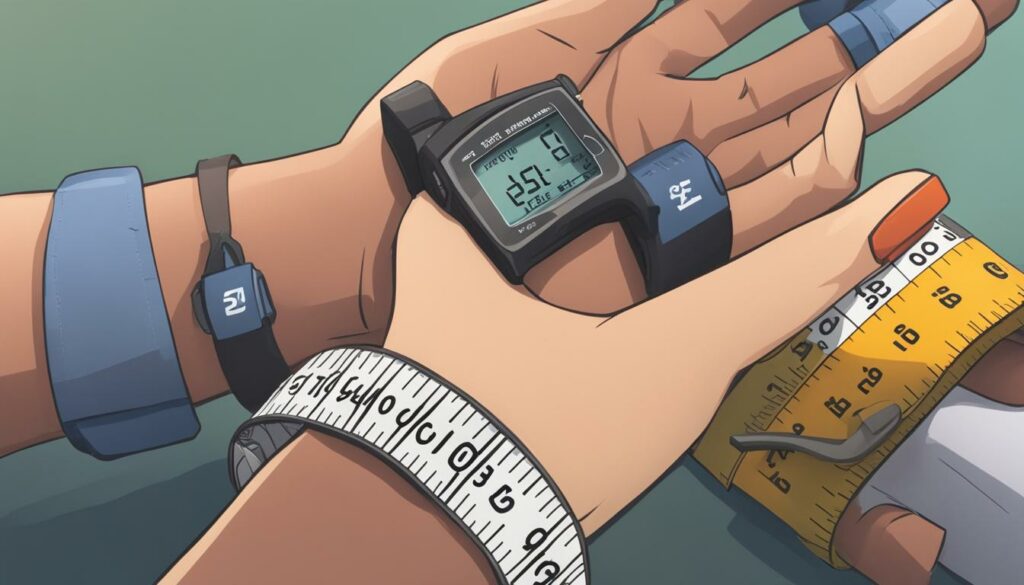
| Benefits of Measuring Wrist Size |
|---|
| Accurate heart rate readings: A snug fit ensures accurate heart rate readings during workouts. |
| Secure placement: A properly fitting heart rate monitor stays securely in place. |
| Enhanced comfort: A snug fit prevents discomfort and irritation during activities. |
| Fitness tracking accuracy: An accurate fit provides precise data for tracking your fitness progress. |
Measuring Your Wrist for Activity Trackers
When it comes to activity trackers, such as smart bands or smartwatches, getting the right fit is crucial for accurate readings. A snug fit ensures that the device stays in place during physical activity, allowing it to accurately track your heart rate and activities. In this section, I will guide you on how to measure your wrist size for activity trackers and provide tips for achieving a snug fit.
To measure your wrist size for an activity tracker, start by using one of the methods mentioned earlier, such as a measuring tape, string and ruler, or a smartphone app. Follow the instructions carefully to obtain an accurate measurement in inches or centimeters. Once you have your wrist measurement, add approximately 1/2 inch (1.25 cm) to the measurement to ensure a proper fit for the activity tracker.
It’s important to note that adding a bit of extra length for activity trackers is different from adding length for other types of jewelry. While adding extra length for comfort is recommended for bracelets, it’s not necessary for activity trackers. A snug fit is essential for accurate readings, so avoid adding too much extra length.
| Activity Tracker | Recommended Wrist Size |
|---|---|
| Smart Band | Wrist measurement + 1/2 inch (1.25 cm) |
| Smartwatch | Wrist measurement + 1/2 inch (1.25 cm) |
Remember, achieving a snug fit is essential for accurate heart rate and activity tracking data. By following the measurement methods and tips provided in this guide, you can ensure that your activity tracker fits comfortably and functions optimally.
![]()
Finding the Perfect Fit for Different Bracelets and Bands
When it comes to finding the perfect fit for your bracelets and bands, it’s important to consider the specific requirements for each type of jewelry. Different materials and styles may require varying levels of snugness or looseness to ensure both comfort and functionality. Let’s explore how to achieve the ideal fit for leather and rubber straps as well as metal bracelets.
Snug Fit for Leather and Rubber Straps
Leather and rubber straps are known for their flexibility and ability to mold to your wrist over time. To ensure a snug fit, it’s recommended to measure your wrist using the methods outlined in earlier sections. Add the recommended extra length for comfort and adjust the strap accordingly to achieve a secure yet comfortable fit. This will prevent the bracelet from sliding around and provide a sleek appearance.
Looser Fit for Metal Bracelets
On the other hand, metal bracelets typically require a slightly looser fit compared to leather and rubber straps. This allows for proper movement and ventilation while maintaining a stylish look. Be sure to measure your wrist accurately and add the extra length for comfort as discussed earlier. However, when adjusting the metal bracelet, leave a little more wiggle room to ensure a comfortable fit without being too tight or restricting blood flow.
By paying attention to these guidelines, you can find the perfect fit for your bracelets and bands. Whether you prefer the snugness of leather or the versatility of metal, ensuring the right fit will enhance your comfort and style. You can confidently wear your favorite accessories knowing that they not only look great but also feel great on your wrist.
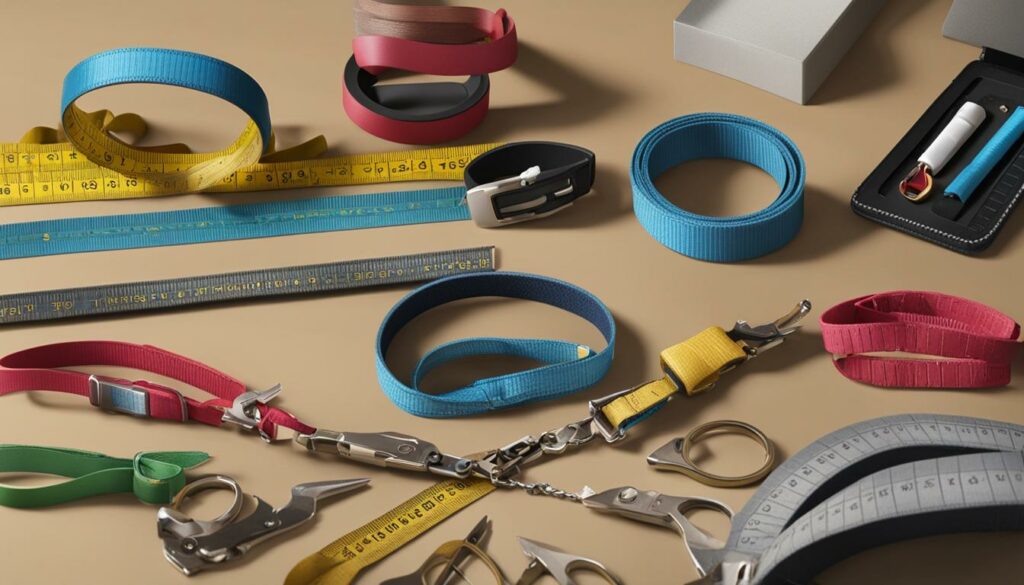
Summary:
- Leather and rubber straps require a snug fit, mold to your wrist, and provide a sleek appearance.
- Metal bracelets should have a slightly looser fit for proper movement and comfort.
- Follow the measurement methods discussed earlier and add extra length for comfort when adjusting your bracelets.
Choosing the Right Size for Jewelry Bracelets
When it comes to selecting the perfect bracelet, finding the right size is essential for a comfortable and stylish fit. Whether you’re looking for a pandora bracelet, bead bracelet, or rope bracelet, taking accurate measurements and considering additional length for comfort is crucial. By following these simple steps, you can ensure that your bracelet fits perfectly and enhances your overall look.
Measuring Your Wrist
The first step in choosing the right bracelet size is to measure your wrist accurately. Use a measuring tape or a piece of string to wrap around the widest part of your wrist, just below the bone. Make sure the tape or string is snug but not too tight. Take note of the measurement in inches or centimeters.
Tip: If you’re using a string, mark the point where it overlaps and then measure it with a ruler for an accurate measurement.
Adding Extra Length for Comfort
Once you have your wrist measurement, it’s recommended to add a bit of extra length for a comfortable fit. This is especially important if you prefer a looser feel or if you’re choosing a bracelet with larger beads or charms. Adding approximately 1/2 inch (1.3 cm) to your wrist measurement is a good rule of thumb to achieve the perfect fit.
Finding the Perfect Fit
When trying on bracelets, make sure they slide over your hand comfortably and sit comfortably on your wrist. A properly fitting bracelet should not be too tight or too loose. It should be snug enough to stay in place but loose enough to move freely. Remember, everyone’s wrist size and personal preference can vary, so it’s crucial to try on different sizes and styles to find the perfect fit.
| Wrist Measurement | Recommended Bracelet Size |
|---|---|
| 5.5″ – 6.0″ | Small |
| 6.0″ – 6.5″ | Medium |
| 6.5″ – 7.0″ | Large |
Keep in mind that this table provides general guidelines. Different brands and styles may have their own size recommendations, so it’s always a good idea to consult the specific sizing chart provided by the retailer or jeweler. By taking the time to measure your wrist and considering additional length for comfort, you can confidently choose the right size for your jewelry bracelets and enjoy a perfect fit every time.
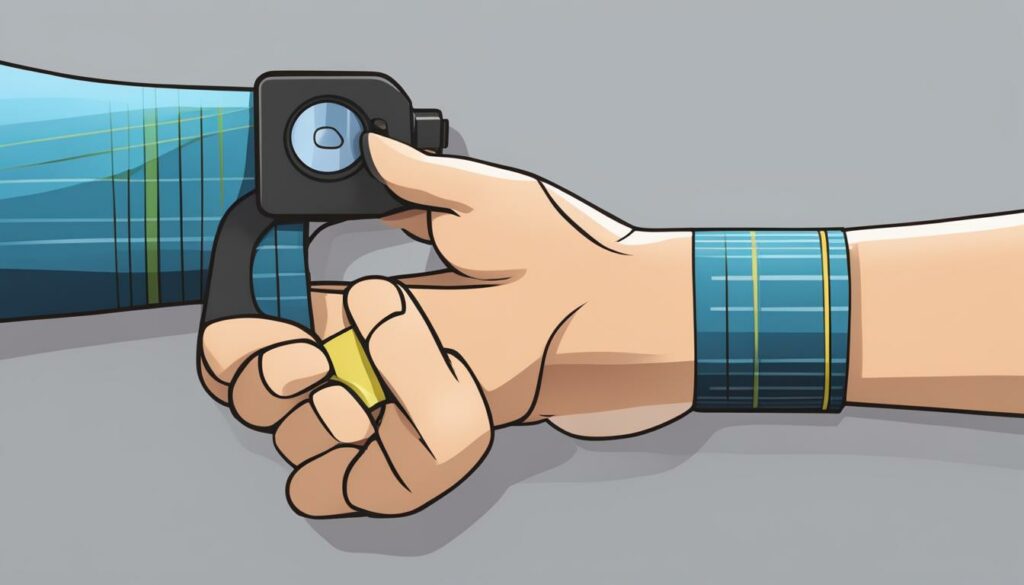
Conclusion
In conclusion, accurately measuring your wrist size is of utmost importance when it comes to finding the perfect fit for watches and bracelets. By following the methods outlined in this guide, you can ensure a comfortable and secure fit for your accessories.
Not only does accurate measurement prevent discomfort and potential damage to your wrist, but it also helps in choosing the right size when shopping either online or in-store. With the tips provided, you’ll be able to confidently select accessories that fit perfectly.
Remember to add a bit of extra length to your wrist measurement for added comfort, and follow the specific guidelines for different types of jewelry. Whether you’re measuring for closed loop bangles, open loop bracelets, heart rate monitors, or activity trackers, accuracy is key.
So, the next time you’re in the market for a new watch or bracelet, take the time to measure your wrist accurately. It will make all the difference in ensuring a comfortable and stylish fit.
FAQ
Why is measuring wrist size important?
Measuring your wrist size ensures a comfortable and secure fit for watches and bracelets. It also helps you choose the correct size when shopping online, reducing the likelihood of returns or exchanges.
How can I measure my wrist size accurately?
There are three methods you can use to measure your wrist size accurately at home: using a measuring tape or ruler, using a string and ruler, or using a smartphone app.
How do I measure my wrist with a measuring tape or ruler?
Simply wrap the measuring tape or ruler around the widest part of your wrist, just below the bone, and record the measurement in inches or centimeters.
What can I do if I don’t have a measuring tape or ruler?
If you don’t have a measuring tape or ruler, you can use a piece of string and a ruler instead. Wrap the string around your wrist, mark the point where it overlaps, and then measure the length with a ruler.
Is there an app I can use to measure my wrist size?
Yes, there are smartphone apps available that can accurately measure your wrist size. Simply download a measuring app, follow the instructions, and use your phone’s screen to measure your wrist.
How do I measure my wrist for different types of jewelry?
For closed loop bangles, measure around your knuckles. For open loop bracelets, measure the width of your wrist.
Should I add extra length to my wrist measurement?
Yes, it’s recommended to add a bit of extra length to your wrist measurement, especially for metal bracelets that can expand with body temperature. Adding 1/2 inch (1.3 cm) is a good rule of thumb for a comfortable fit.
Can my wrist measurement determine my body frame size?
Yes, by comparing your wrist size to your height using a body frame size chart, you can determine if you have a small, medium, or large frame. This information may be useful for assessing ideal weight or body mass index.
How should I measure my wrist for a heart rate monitor?
For accurate heart rate readings, it’s important to ensure a snug fit. Follow the measurement methods described earlier, but refrain from adding any extra length for comfort.
How should I measure my wrist for activity trackers?
Activity trackers, such as smart bands or smartwatches, require a snug fit for accurate readings. When measuring your wrist size for these devices, add approximately 1/2 inch (1.25 cm) to your measurement.
Do different bracelets and bands require different levels of snugness?
Yes, different types of bracelets and bands require varying levels of snugness for the perfect fit. Leather and rubber straps should fit more snugly, while metal bracelets should have a slightly looser fit.
How do I choose the right size for jewelry bracelets?
When selecting a bracelet, it’s crucial to find the right size. Adding 1/2 inch (1.3 cm) to your wrist measurement is typically recommended to achieve a comfortable fit.
Source Links
- https://www.wikihow.com/Measure-Wrist-Size
- https://lackorecouture.com/blogs/bracelets/how-to-measure-wrist-size
- https://theslenderwrist.com/measure-your-wrist/

Hey Fashion Enthusiasts! My wife Chantal and I, have been so fortunate to be able to share our latest inspiration and trends in the jewelry and accessory industry, and more so, to get this amazing feedback from our ever growing community. Where my wife focusses more on all things rings, weddings and female jewelry, I love to scoop out the newest accessories for men. I roam around the world to find the latest watches, bags, sunglasses, scarfs, wallets, you name it and I’ll deliver! I always commit to doing a lot of research to share my reviews and personalized advice on this blog or on our store. If you do not know what to wear, send me an email and I will help you out!
